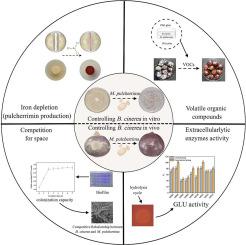葡萄灰霉病防治剂的生物前景及其潜在作用方式
IF 5.2
1区 农林科学
Q1 FOOD SCIENCE & TECHNOLOGY
International journal of food microbiology
Pub Date : 2025-08-05
DOI:10.1016/j.ijfoodmicro.2025.111383
引用次数: 0
摘要
葡萄采后灰霉病主要由葡萄灰霉病引起,合成杀菌剂是防治葡萄灰霉病的主要方法。拮抗酵母为收获后的病原体管理提供了一种可行的替代传统杀菌剂。本研究分析了14株pulcherrima Metschnikowia酵母菌株对葡萄灰霉病的防治效果,并探讨了其可能的作用机制。体外分析表明,所有酵母菌(100 μL, 1 × 104 CFU/mL)均能显著抑制灰绿杆菌菌丝生长,抑制率为7% (MP13) ~ 81% (MP07)。随后的体内抗真菌试验证明了MP07在预防葡萄灰霉病方面的功效。重要的是,一项全面和系统的机制分析首次揭示了同一物种菌株之间抗菌途径的明显差异。MP07生物膜形成水平最高(OD590为0.68;100 μL, 1 × 107个细胞/mL)和pulcherrimin产量(光晕直径2.35 cm;10 μL, 1 × 108个细胞/mL)。MP14 (20 μL, 1 × 108个细胞/mL)通过产生挥发性有机物(VOCs)表现出较强的抗真菌活性(100%),而MP11 (20 μL, 1 × 108个细胞/mL)表现出最高的β-1,3-葡聚糖酶活性(80.78 U1),引入灰绿杆菌后,其活性进一步提高到100.96 U1。这些发现强调,生物防治剂的筛选必须扩展到菌株水平,需要对其抗真菌机制进行精确评估。通过利用菌株特异性抑制途径,可以设计有针对性的组合策略。综上所述,本研究为开发高效、安全、稳定的生物防治制剂奠定了理论基础,为复杂的多物种制剂提供了可行的替代方案。本文章由计算机程序翻译,如有差异,请以英文原文为准。

Bioprospection of Metschnikowia pulcherrima as biocontrol agents against gray mold on grapes with their potential modes of action
Gray mold in grapes during the postharvest period is primarily caused by Botrytis cinerea, with synthetic fungicides being the main method of control. Antagonistic yeasts offer a viable alternative to conventional fungicides for the management of pathogens post-harvest. The study analyzed the effectiveness of 14 Metschnikowia pulcherrima yeast strains against gray mold in grapes and examined their potential mechanisms of action. In vitro analyses demonstrated that all evaluated yeast strains (100 μL, 1 × 104 CFU/mL) significantly inhibited the mycelial growth of B. cinerea, with inhibition rates ranging from 7 % (MP13 strain) to 81 % (MP07 strain). Subsequent in vivo antifungal assays demonstrated MP07's efficacy in preventing gray mold on grapes. Critically, a comprehensive and systematic mechanistic analysis revealed, for the first time, distinct variations in antimicrobial pathways among strains of the same species. MP07 exhibited the highest levels of biofilm formation (OD590 of 0.68; 100 μL, 1 × 107 cells/mL) and pulcherrimin production (halo diameter of 2.35 cm; 10 μL, 1 × 108 cells/mL). In contrast, MP14 (20 μL, 1 × 108 cells/mL) demonstrated superior antifungal activity (100 %) through the production of volatile organic compounds (VOCs), while MP11 (20 μL, 1 × 108 cells/mL) exhibited the highest β-1,3-glucanase activity (80.78 U1), which further increased to 100.96 U1 upon the introduction of B. cinerea. These findings underscore that screening for biocontrol agents must extend to the strain level, necessitating precise evaluation of their antifungal mechanisms. By leveraging strain-specific inhibitory pathways, targeted combinatorial strategies can be devised. In conclusion, this study lays a theoretical groundwork for developing highly effective, safe, and stable biocontrol agents through precision-based intra-species strain selection, offering a viable alternative to complex multi-species formulations.
求助全文
通过发布文献求助,成功后即可免费获取论文全文。
去求助
来源期刊
CiteScore
10.40
自引率
5.60%
发文量
322
审稿时长
65 days
期刊介绍:
The International Journal of Food Microbiology publishes papers dealing with all aspects of food microbiology. Articles must present information that is novel, has high impact and interest, and is of high scientific quality. They should provide scientific or technological advancement in the specific field of interest of the journal and enhance its strong international reputation. Preliminary or confirmatory results as well as contributions not strictly related to food microbiology will not be considered for publication.

 求助内容:
求助内容: 应助结果提醒方式:
应助结果提醒方式:


